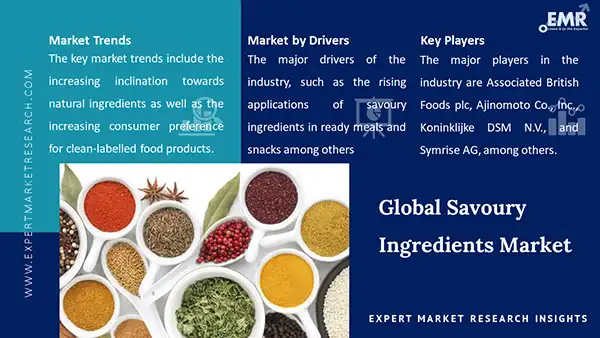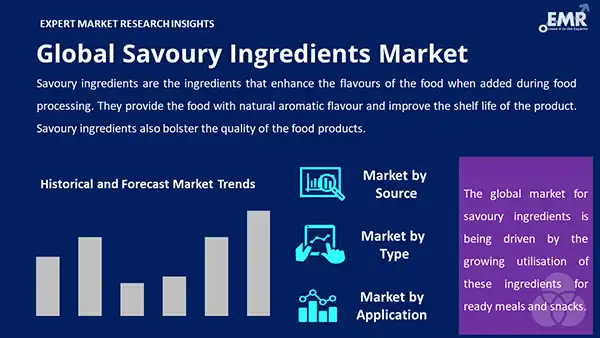
Consumer Insights
Uncover trends and behaviors shaping consumer choices today
Procurement Insights
Optimize your sourcing strategy with key market data
Industry Stats
Stay ahead with the latest trends and market analysis.
The global savoury ingredients market stood at a value of more than USD 9.77 Billion in 2025. The market is further expected to grow at a CAGR of 7.80% in the forecast period of 2026-2035 to attain a value of over USD 20.71 Billion by 2035.
Base Year
Historical Period
Forecast Period
Compound Annual Growth Rate
7.8%
Value in USD Billion
2026-2035
*this image is indicative*
The monosodium glutamate (MSG) segment, based on type, accounts for a significant share in the market owing to a wide range of applications of the product, along with its low cost. Monosodium glutamate has the ability to enhance the savoury, meaty, and umami flavours of the foods or dishes and is utilised in frozen foods, spice mixes, canned and dry soups, salad dressings, and meat and fish-based food products. Furthermore, the growing demand for MSG in Asian and Western cooking is anticipated to augment the growth of the segment.

Read more about this report - REQUEST FREE SAMPLE COPY IN PDF
The market for savoury ingredients in the Asia Pacific is driven by the thriving food industry in the region, which is supported by the changing lifestyles, rising disposable income, and the growing population in the region. Additionally, the regional market is expected to be propelled by the rising demand for fish and meat products. Furthermore, the growing popularity of Asian cuisines owing to a significant growth of the travel and tourism industry in countries like India, China, Japan, South Korea, and others is anticipated to augment the market expansion in the region.

Read more about this report - REQUEST FREE SAMPLE COPY IN PDF
Savoury ingredients are the ingredients that enhance the flavours of the food when added during food processing. They provide the food with natural aromatic flavour and improve the shelf life of the product. Savoury ingredients also bolster the quality of the food products.
Market Breakup by Source
Market Breakup by Type
Market Breakup by Application
Market Breakup by Region
The global savoury ingredients industry is driven by the rising utilisation of savoury ingredients in ready meals and snacks. This can be attributed to the growing advancements in the food processing sector and the rising demand for ready-to-eat food products. Nowadays, snacks and ready meals come in a range of diverse flavours and natural aromas, achieved by the addition of savoury ingredients. Furthermore, the growing competition among the major food manufacturing companies, coupled with the cost-effectiveness and easy availability of fish and meat-based meals and snacks, is likely to augment the market growth in the forecast period.
The report gives a detailed analysis of the following key players in the global savoury ingredients market, covering their competitive landscape, capacity, and latest developments like mergers, acquisitions, and investments, expansions of capacity, and plant turnarounds:
The comprehensive EMR report provides an in-depth assessment of the market based on the Porter's five forces model along with giving a SWOT analysis.




*While we strive to always give you current and accurate information, the numbers depicted on the website are indicative and may differ from the actual numbers in the main report. At Expert Market Research, we aim to bring you the latest insights and trends in the market. Using our analyses and forecasts, stakeholders can understand the market dynamics, navigate challenges, and capitalize on opportunities to make data-driven strategic decisions.*
Get in touch with us for a customized solution tailored to your unique requirements and save upto 35%!
In 2025, the global savoury ingredients market attained a value of more than USD 9.77 Billion.
The market is estimated to grow at a CAGR of 7.80% between 2026 and 2035.
The market is estimated to witness a healthy growth in the forecast period of 2026-2035 to reach over USD 20.71 Billion by 2035.
The major regions in the industry are North America, Latin America, the Middle East and Africa, Europe, and the Asia Pacific.
The major drivers of the industry, such as the rising applications of savoury ingredients in ready meals and snacks and the growing popularity of spicy and bitter-sweet foods, are expected to aid the market growth.
The key market trends guiding the growth of the industry include the increasing inclination towards natural ingredients as well as the increasing consumer preference for clean-labelled food products.
Natural and synthetic are the different sources considered within the market report.
Yeast extract, starch, hydrolysed vegetable protein, hydrolysed animal protein, nucleotides, and monosodium glutamate, among others are the major types of savoury ingredients.
Ready meals, snacks, and feed, among others are the different applications of savoury ingredients.
The major players in the industry are Associated British Foods plc, Ajinomoto Co., Inc., Givaudan SA, Koninklijke DSM N.V., and Symrise AG, among others.
Explore our key highlights of the report and gain a concise overview of key findings, trends, and actionable insights that will empower your strategic decisions.
| REPORT FEATURES | DETAILS |
| Base Year | 2025 |
| Historical Period | 2019-2025 |
| Forecast Period | 2026-2035 |
| Scope of the Report |
Historical and Forecast Trends, Industry Drivers and Constraints, Historical and Forecast Market Analysis by Segment:
|
| Breakup by Source |
|
| Breakup by Type |
|
| Breakup by Application |
|
| Breakup by Region |
|
| Market Dynamics |
|
| Competitive Landscape |
|
| Companies Covered |
|
| Report Price and Purchase Option | Explore our purchase options that are best suited to your resources and industry needs. |
| Delivery Format | Delivered as an attached PDF and Excel through email, with an option of receiving an editable PPT, according to the purchase option. |
Datasheet
One User
USD 2,499
USD 2,249
tax inclusive*
Single User License
One User
USD 3,999
USD 3,599
tax inclusive*
Five User License
Five User
USD 4,999
USD 4,249
tax inclusive*
Corporate License
Unlimited Users
USD 5,999
USD 5,099
tax inclusive*
*Please note that the prices mentioned below are starting prices for each bundle type. Kindly contact our team for further details.*
Flash Bundle
Small Business Bundle
Growth Bundle
Enterprise Bundle
*Please note that the prices mentioned below are starting prices for each bundle type. Kindly contact our team for further details.*
Flash Bundle
Number of Reports: 3
20%
tax inclusive*
Small Business Bundle
Number of Reports: 5
25%
tax inclusive*
Growth Bundle
Number of Reports: 8
30%
tax inclusive*
Enterprise Bundle
Number of Reports: 10
35%
tax inclusive*
How To Order

Select License Type
Choose the right license for your needs and access rights.

Click on ‘Buy Now’
Add the report to your cart with one click and proceed to register.

Select Mode of Payment
Choose a payment option for a secure checkout. You will be redirected accordingly.
Gain insights to stay ahead and seize opportunities.

Get insights & trends for a competitive edge.

Track prices with detailed trend reports.

Analyse trade data for supply chain insights.

Leverage cost reports for smart savings

Enhance supply chain with partnerships.

Connect For More Information
Our expert team of analysts will offer full support and resolve any queries regarding the report, before and after the purchase.
Our expert team of analysts will offer full support and resolve any queries regarding the report, before and after the purchase.
We employ meticulous research methods, blending advanced analytics and expert insights to deliver accurate, actionable industry intelligence, staying ahead of competitors.
Our skilled analysts offer unparalleled competitive advantage with detailed insights on current and emerging markets, ensuring your strategic edge.
We offer an in-depth yet simplified presentation of industry insights and analysis to meet your specific requirements effectively.
Share